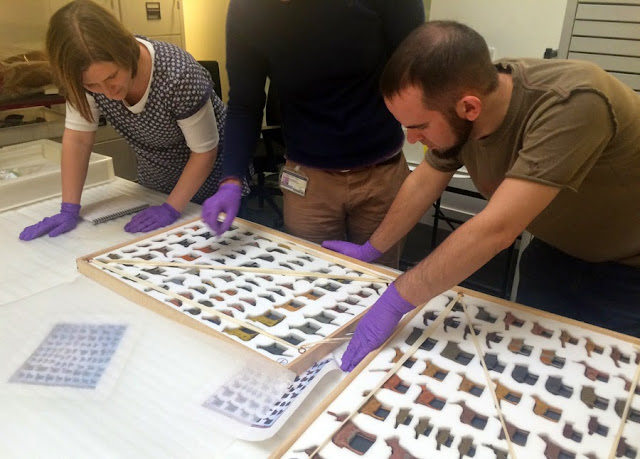We eventually whittled a long list of 650+ objects down to 190. Using a large table we created a 'mock-up' outlining how the material might be arranged (and to ascertain that it would all fit!)
 |
| Woodwork layout © Pitt Rivers Museum |
The main sections are concerned with carpentry (including joinery), carving, natural form, pyroengraving, fretwork, and veneer/marquetry.
You can see on the centre-right we've left a space called 'NOH'. This was for the inclusion of three new Noh masks from Japan, specially commissioned by the project from a master craftsman in Tokyo. Hideta Kitazawa's series and notes documented the process of making such a mask, from the selection of 300-year-old Hinoki (Japanese Cypress) wood, to the use of hammers and chisels, urushi lacquer and 30 coats of white oyster-shell paint. The finished mask is a ko-omote mask, depicting a beautiful teenage girl.
 |
| Hideta Kitazawa making a ko-omote Noh mask for the Museum's displays © Pitt Rivers Museum |
This video shows Hideta demonstrating Noh mask carving in Australia in 2015:
Another highlight in the display is a fantastic Noah's ark, known to date to before 1860. Originally thought to have been made in Worcester, comparison with other existing examples indicated that it was more likely made in the town of Seiffen in the Erzgebirge (Ore Mountains) region of eastern Germany. Seiffen has been renowned for its wooden toy industry since the 18th century, and more than half the town's population is still employed in the woodworking trade.
 |
| Noah's Ark, Grühainichen, Germany, 19th century PRM 1956.9.70 |
We included this object to illustrate two separate processes - straw marquetry and tyre-turning. The sides of the ark have been painstakingly covered with glued strips of straw, which have been soaked in water for different lengths of time to produce varying shades of gold and brown. Its 255 animals and birds have been produced using an ingenious method called Reifendrehen ('tyre turning') which enabled the cheap and efficient production of lots of wooden animals. A large disc of fir wood is put on a lathe to create a tyre-like 'Seiffen ring' of 30-50cm diameter, the cross-section of which takes the form of the desired animal. Small slices are taken from the ring, which are finished and painted by hand. Many of the makers had never seen exotic animals and so used their imaginations to create green hyenas and red camels. We've deliberately placed this object low down in the case so that children can see it.
 |
| Choosing a selection from the 255 toy animals to display with the ark © Pitt Rivers Museum |
 |
| This unicorn was not part of a pair. Might it not have made it on to ark, thus explaining its 'extinction'?! |
 |
| From a series entitled Reifendreher by Johannes Geyer, 2014. Reproduced under the CC BY-NC 4.0 licence |
Another example in the 'Marquetry and Inlay' section is this beautiful Qur’an stand from Iran that folds out to an 'X' shape. Folding lecterns, or rahla, are among the oldest and most valuable furnishings in a mosque. Designed to support a large Qur’an, the Muslim holy book, early rahla were often made of luxury woods such as walnut or teak, and decorated with sumptuous inlay or openwork carving. This example is inlaid with wood and gold stars in a geometric pattern.
 |
| Qur'an stand, Iran. PRM 1965.12.46 A © Pitt Rivers Museum |
My other favourite object in this case is neither beautiful nor remarkable, but it has a vernacular and rustic charm that is hard to resist. It is a large disc, around 33cm in diameter, carved with concentric circles of Icelandic script. It is a bread stamp, the inscription carved back-to-front so that it would appear the right way around when stamped into the bread dough prior to baking.
 |
| Bread stamp, Iceland. PRM 1900.13.2 © Pitt Rivers Museum Original view (left) and reversed (right) to enable the inscription to be read |
FRÓNI ÁRTAL 1876 JD; BLESSI HERRAN ÞETTA VORT Á BORÐI BRAUÐ; SJER HVER MAÐUR ROMI, SÁR AÐ GRENNIST SULTAR NAUÐ
“Iceland, year 1876 JD; May the Lord bless this bread on our table in order to diminish the sore pain of hunger; this every single man should say.”
As you can see, there is a lot of variety in this display. I hope that next time you visit, you have time to head to the Lower Gallery to have a look at these intriguing objects in the flesh.
Helen Adams
Project Curator & Engagement Officer

No comments:
Post a Comment
Let us know what you think...